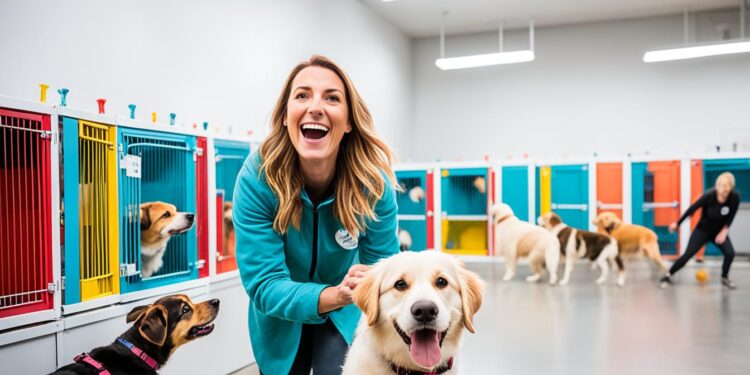Behind the Scenes at a Dog Shelter: Stories of Hope and Love

Have you ever wondered what goes on behind the doors of a dog shelter? What stories of hope and love unfold within those walls, as dedicated staff and volunteers work tirelessly to provide care and find forever homes for these furry companions?
At a dog shelter, every dog has a unique story to tell, filled with both challenges and triumphs. Many of these dogs come from abusive or neglected backgrounds, carrying emotional baggage that requires special attention and understanding. It is within these shelter walls that their journey of healing and transformation begins.
When dogs arrive at the shelter, they may exhibit a range of issues and learned behaviors based on their past experiences. Fear, anxiety, and aggression are just some examples of the emotional scars they carry. Prospective adopters need to be aware of these potential challenges and be willing to put in the time and effort required to help these rescue dogs overcome their past traumas and become cherished members of a loving family.
Join me as we delve into the behind-the-scenes world of a dog shelter, explore stories of hope and love, and discover the incredible impact that adoption can have on the lives of these incredible animals.
Challenges of Fostering and Rescuing Homeless Dogs
Homeless dogs are facing a critical situation, with many of them dying in shelters across the country. It is heart-wrenching to see these innocent creatures suffering and desperate for a second chance at life. Fortunately, there are individuals passionate about animal welfare who are taking action to save and care for these dogs.
One of the key steps in helping homeless dogs is through fostering. Fostering provides them with a temporary home where they can experience the love, care, and stability of a family environment. This crucial step allows dogs to heal emotionally, physically, and behaviorally, preparing them for their forever homes.
By fostering, dogs have the opportunity to get acclimated to living with a family, which helps them in adjusting to a home environment. Many rescue dogs come with fear, anxiety, and behavioral issues as a result of their past trauma. Foster families play a vital role in helping these dogs overcome their challenges and learn to trust again.
Foster families provide shelter, attention, socialization, and food for the dogs. They invest their time and effort into their temporary companions, working to rehabilitate and nurture them. Additionally, foster families help the dogs find forever homes by taking them to adoption events, where potential adopters can meet them in person and witness their unique personalities.
| Challenges of Fostering Homeless Dogs | Key Strategies for Overcoming Challenges |
|---|---|
| 1. Behavioral issues | – Provide consistent training and positive reinforcement – Seek professional guidance from dog trainers or behaviorists |
| 2. Emotional trauma | – Offer a safe and secure environment – Provide love, patience, and understanding |
| 3. Time commitment | – Dedicate time for exercise, play, and bonding – Manage schedule and prioritize the needs of the foster dog |
| 4. Separation anxiety | – Gradually introduce periods of separation – Use calming techniques and provide comfort items |
| 5. Medical care | – Ensure regular vet check-ups – Administer medications and treatments as needed |
Fostering dogs may come with its challenges, but the rewards far outweigh them. Seeing a foster dog transform from a scared and anxious state to a happy, confident, and well-adjusted companion brings immense joy. And while saying goodbye to a foster dog can be bittersweet, knowing that they have found a forever home and seeing the positive impact made in their lives makes it all worthwhile.
The Joy and Challenges of Fostering Dogs
Fostering dogs can be an incredibly rewarding experience for dog lovers, but it also comes with its fair share of challenges. When you open your home and heart to a foster dog, you embark on a journey of love, compassion, and growth.
Being a foster parent requires providing a safe and loving environment for these dogs. Many of them come from difficult backgrounds and may have fear or behavioral issues. It is our responsibility to help them overcome these challenges by offering patience, understanding, and a structured routine. Additionally, as fosters, we must be vigilant in attending to their medical needs, ensuring they receive proper veterinary care and any necessary treatments.
One of the advantages of fostering is the opportunity to help these dogs acclimate to living in a family environment. Through love, guidance, and consistency, we can help them build trust and confidence, increasing their chances of finding a permanent home. During their stay, foster dogs receive individual attention, socialization, and basic training, which can make a world of difference in their journey towards a forever family.
As foster parents, we have the unique privilege of advocating for our furry charges. By sharing their stories and showcasing their unique personalities, we can attract potential adopters and help these dogs find their perfect match. Through social media platforms, adoption events, and word-of-mouth, we have the power to make a meaningful impact in their lives.
While it may be difficult to say goodbye when it’s time to let go of our foster dogs, it’s essential to remember the bigger picture. Fostering saves lives and creates space for more dogs to be rescued and cared for. By opening our hearts and homes, we can provide a temporary safe haven for these dogs and play a crucial role in their journey towards finding a forever home.
FAQ
Can rescue dogs come with emotional baggage?
What challenges can rescue dogs bring?
How can I help homeless dogs?
What is fostering and how does it help dogs?
What does fostering involve?
What are the advantages of fostering dogs?
Is fostering dogs a rewarding experience?
How do I cope with letting go of a foster dog?
Source Links
- https://www.aslobcomesclean.com/2019/03/behind-the-scenes-of-fostering-dogs-dontsweatyourpet-swifferfanatic-sponsored-post/
- https://www.outislandlifebahamas.com/2017/03/behind-the-scenes-of-a-rescue-dog/
- https://medium.com/@deniseboehler/the-love-and-the-fury-why-dog-lovers-are-in-angst-in-our-world-cd65503b7e4e






